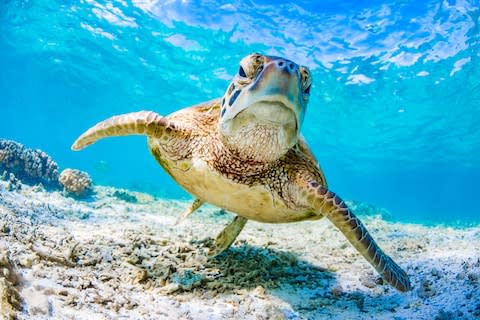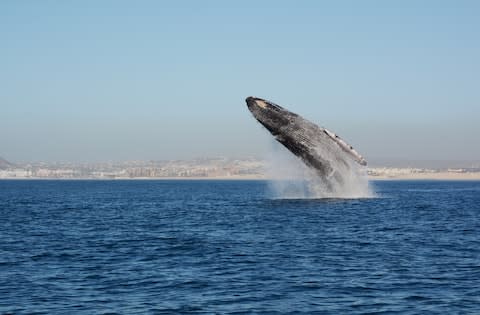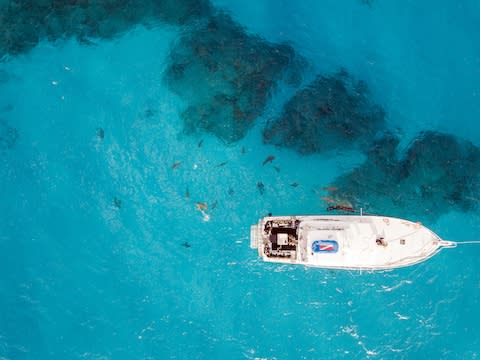Blue Planet is back – here's how to visit the incredible locations

Tossing £5,000 worth of electrical equipment over the side of a Zodiac inflatable boat might seem foolish, but the sophisticated piece of gadgetry I’m lowering into the icy Southern Ocean could reward me with far greater intelligence on the state of Antarctica than any expedition cruise ship lecture or illustrated field guide.
Deployed off Cuverville Island, where moulting gentoo penguin chicks are getting ready for their maiden dip, the CastAway device reveals that water salinity is lower than average – a worrying trend seen in glacial regions at both poles, according to the naturalist Bob Gilmore.
Locked for millions of years in ice sheets smothering the White Continent, fresh water is flooding and diluting our oceans – and I’m seeing it in real time with my own eyes.
Trundling at an idle speed, we trawl a net behind us, collecting samples of phytoplankton, a microscopic marine plant heavily affected by changes in salt levels. The foundation of an aquatic food chain, these translucent organisms are the lungs of the ocean, an invisible force producing 80 per cent of the oxygen in our atmosphere.
“Every other breath you take, think of these guys,” says Gilmore, as floating ice debris gasps and crackles.
Data collected from our excursion will be sent to the Scripps Institution of Oceanography at the University of California as part of a long-term Fjord Phyto study, in which tourists get to play the part of scientists, contributing to important research and – most importantly – appreciating why it really matters.

The Citizen Science programme was pioneered by expedition cruise company Polar Latitudes and is offered on all of its Antarctic voyages. During my two-week trip with Island Sky, I participated in a bird census, studied cloud patterns on behalf of Nasa and helped plot the migration paths of humpback whales by uploading photographs of their flukes to cetacean ID network Happywhale.com.
We also crossed paths with sister ship Hebridean Sky, carrying a BBC crew which was working in conjunction with the private Woods Hole Oceanographic Institution to film the tagging of humpbacks with trackers to monitor their feeding habits, potentially forming a segment for the BBC programme Blue Planet Live.
Starting tonight on BBC One and continuing Wednesday to Friday and next Sunday, the ambitious broadcast aims to build upon the legacy of Blue Planet II, presenting viewers with scientific facts about the health of our oceans and looking at the challenges posed by plastics, overfishing, noise pollution and rising water temperatures.
Chris Packham, Liz Bonnin and Steve Backshall will be reporting from locations across the globe, meeting pioneering scientists and encountering the wonderful marine inhabitants whose lives are still largely a mystery.
Based on viewing figures for the 2017 landmark series, which averaged 13 million in the UK, Blue Planet Live’s executive producer Roger Webb believes there has been a shift in nature documentary making. “There’s an appetite for conservation stories, and television is a powerful tool for promoting the protection of our planet,” he said.
Beyond the small screen, those changes are being felt in the field, where travellers are no longer content to be bystanders; instead, they want to know what’s really going on behind the scenes.
Back on board Island Sky, we studied one of our water samples under a microscope, looking for evidence of microplastics. Thin fibrous strands wafted around a Petri dish like fallen hairs, a residue of man-made fabrics spewed from ships’ washing machines. “We think this environment is pristine,” said Gilmore, “but the wilderness is not so disconnected from the rest of the world.”
It’s a sobering and solemn thought, but feelings of sadness were soon displaced by anger and determination. Harsh realities can breed despondency, but they also inspire activism.
From the ship’s stern, I watched a migrating humpback dive into the glassy waters of Paradise Bay. Against a bruised and frigid twilight sky, light danced on his tail fluke, trickling like golden syrup into the water.
Once fodder for my camera frame, the creature ahead of me was now an individual, and I wondered where – and in what health – he might end up in several months’ time. Crucially, more than ever, I cared.
Polar Latitudes offers a Whale Science Voyage. Departure from Feb 27 to March 11 2020, from £10,963 per person for a porthole cabin (two sharing) on an all-inclusive basis. Flights cost extra. Book via swoop-antarctica.com.
The three key locations from Blue Planet Live – and how to visit them
Great Barrier Reef, Australia
Liz Bonnin

Curving 1,430 miles (2,300km) around the east coast of Australia, hundreds of coral reefs and islands connect to form the world’s largest underwater metropolis, a thriving mass of calcium carbonate high-rises, brittle forests and rainbow-hued gardens, used by millions of aquatic commuters, day and night.
For the next week, Liz Bonnin will be based on Heron Island in the southern sector of the Great Barrier Reef, a location she believes is “one of the most beautiful places on earth”.
While sections elsewhere have been battered and bleached by cyclones and rising water temperature, this area is a reminder of the reef’s pristine past.
“Beneath the surface, the harrowing truth is that the oceans are suffering like never before,” said Bonnin, who has been filming at the Turtle Rehabilitation Centre on Fitzroy Island, further north off Cairns.
Grim estimates suggest that up to half of the Great Barrier Reef has been bleached to death since 2016 – a rate that seems unstoppable. But far from being downbeat, Bonnin claims there is hope, largely in the form of scientists such as Prof Peter Harrison, from Southern Cross University, who is spearheading a “coral IVF” project.
“To think about collecting eggs and sperm from a mass spawning event that happens just once [a year] in the middle of the night is already a difficult enough feat,” admitted Bonnin, who will be diving to see if a recently reseeded patch of reef is recovering successfully.
“But it’s not just about the scientists,” she added, directing the issue right into our living rooms. “It’s also about individuals and what we can do, otherwise all that work is futile.”
Abercrombie & Kent (01242 547826; abercrombiekent.co.uk) offers a seven-night Queensland holiday, including three nights in Brisbane and four nights at Heron Island Resort, from £2,750pp (sharing). Includes flights, transfers and accommodation.
Baja Peninsula, Mexico
Chris Packham

An arid, cacti-covered finger of land soothed by the Pacific Ocean and the Sea of Cortez, Mexico’s 745-mile (1,200km) Baja peninsula welcomes cetaceans from far and wide, which come here to forage and train their calves in nurseries between December and April.
Since the mid-Seventies, grey whales have been at the centre of an ecotourism success story, attracting visitors to lagoons on boat trips organised by local communities. Undergoing an extraordinary character transformation, the typically shy creatures appear to invite human interaction – although a sceptical Chris Packham says he may have to draw the line at patting a whale’s head on live TV.
“I’ll have to make a judgment on whether that whale is going to gain anything from it,” he mused from his base in the Loreto Marine Reserve. “I’m not a big one for touching wild animals.”
Instead, the outspoken conservationist prefers to switch on other senses. A few days ago, he saw, smelt and heard his first blue whale, an ocean giant that has eluded him until now.
“The size of the blow dwarfs anything I have seen,” he recalled. “It was like an enormous fountain shooting into the sky.”
In preparation, Packham has been meeting with scientists to discover new, non-invasive methods of gathering data: examining discarded skin sloughs, using hydrophones to record communication, and deploying a drone fitted with a Petri dish to collect blow samples – a gadget he affectionately calls a “snotbot”.
Baja is under threat from human activities such as overfishing and river water extraction. “It’s a microcosm of the world; it has its problems and it has people working hard to find solutions.”
Irrespective of any issues, Packham is adamant nothing can detract from the beauty of the place and the magic of encountering its wild inhabitants.
“On our first day, in less than an hour, we came across a pod of 700 common dolphins,” he recalled, still uplifted by the moment. “They were all around the ship, bow-riding right underneath me. It was one of the most exhilarating and reassuring experiences – that abundance of animals in good health.
“They move through a medium which we can’t with such aptitude and grace. I would give anything to be one of them for just five minutes.”
Cetaceans expert Mark Carwardine (markcarwardine.com) offers 12-day whale-watching trips to Baja on charters with The Spirit of Adventure, from £5,395pp (sharing). Flights cost extra. Various departures from February to April 2020.
The Bahamas
Steve Backshall

A scattering of 700 emeralds wrapped with silky sapphire swirls, the Bahamas is a paradise both above and below the surface; while sun-worshippers unwind on tropical beaches, some of the ocean’s finest predators seek refuge in the archipelago’s protected waters.
In 2011, shark fishing was banned within a 243,000 sq mile area, making this a premier region for diving encounters with up to 40 different species. “It’s one of the only places in the world that enjoys this level of protection,” said Steve Backshall, “and shark numbers have bounced back here in a huge way.”
A keen shark diver, Backshall has worked for more than two decades with pioneering scientists from the Sharklab field station on South Bimini.
From December to April, he explained, great hammerheads are drawn to cooler waters lapping the island just 50 miles (80km) from the coast of Florida. Often found swimming in shallow areas, they can be seen by divers of any level if accompanied by a guide.
As part of the series, Backshall hopes to pull off a live dive with these predators, which he describes as “simply the most dramatic animal I know”.
But with high waves and winds delaying rehearsals, the challenge ahead is getting in the water at all.
Since Backshall first dived here in 2000, he has noticed a remarkable change in the seascape – and unlike in other parts of the world, it has largely been for the better.
“It’s very difficult not to be bleak about the future, until you get to spend time somewhere like the Bahamas, where conservation is really working,” he said, while emphasising that there is still a lot of work to do.
“The fate of our oceans hangs in the balance. Unless we wake up and act now, our land will be surrounded by endless barren blue.”
Dive Worldwide (01962 302087; diveworldwide.com) offers a tailor-made 10-day Great Hammerhead Encounters on Bimini from £3,095pp (sharing). The price includes flights, room-only accommodation and 12 dives with tanks and weights. Available from January to March.
